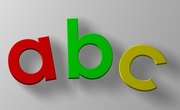Sight words are words that a reader automatically recognizes without having to use picture clues or sound them out. These words include very common words, such as "the" and "you," and "make up 60 to 70 percent of most reading tasks," according to Sandra Fleming, a teacher and writer for the literacy-promoting website, All Info About Reading. After learning these words, a reader should be able to read almost any basic reading material.
The Function of Sight Words
Sight words can be used to teach children how to read. This method of teaching reading is known as the whole language approach. Visual learners especially benefit from learning sight words, according to Sharon Cromwell in the Education World article, "Whole Language and Phonics: Can They Work Together?" Phonics involve sounding out words, and many of the words in the sight word lists cannot be sounded out. The whole language approach encourages children to learn words by recognition without using any sort of phonics method.
The Importance of Sight Words
The importance of sight words starts at the beginning of elementary school because these words form the core words of most elementary school reading materials. If a student can master sight words at an early age, he will be able to read the majority of readings he is given in the first years of elementary school. Fleming recommends in her All Info About Reading article, "The Importance of Sight Words," that parents and teachers should "monitor sight word mastery carefully in early elementary school to be sure that this important skill is being learned."
Sight Words Lists
According to Fleming, the most popular sight word list is the Dolch Word List, compiled by Edward William Dolch, Ph.D., and published in 1948. Not only used to teach English-speaking children how to read, this list of 220 words is in wider use in many English as a Second Language courses. Another popular sight word list is Fry's Instant Words list, compiled by Edward B. Fry, Jacqueline E. Kress and Dona Lee Fountoukidis and published in 1993. This list consists of the 1,000 most common words in the English language.
Sight Word Activities
The website for the Dolch Word List, DolchSightWords.org, offers activities, including the games "Bingo" and "Hangman" and flashcards of sight words. Parents and teachers can also find sight word activities on teacher websites, such as the msrossbec.com website from Cresco, Pennsylvania. The website provides sight word lists by grade level, flashcards and links to other sight word resources.
The Benefits of Using Sight Words
If students master learning sight words in their elementary years, they will be less likely to have reading problems later in life. As Fleming states, it is a "vital skill" that needs to be learned in elementary school. However, if older students learning English have problems reading, they can get help from sight word tutoring because "a competent literacy tutor will check this area carefully and reteach these words as needed to build confidence and reading efficiency."
The Difference Between Sight Words and Phonics
When learning to read, kids are exposed to two different kinds of words: decodable words and non-decodable words. Educators define sight words as non-decodable words because they cannot be decoded by sounding them out or applying the rules of phonics. Phonics, on the other hand, refers to the process of decoding words by correlating letters to the sounds they make. Students can use phonics to sound out unfamiliar words. Mastering both the recognition of sight words and the decoding of unfamiliar words through phonics can help kids become highly effective readers.
Related Articles
References
Writer Bio
Based in Nashville, Tenn., Sally Worsham is a lifelong writer and has previously written for such AOL Living sites as ParentDish and That's Fit. She holds both a Bachelor of Arts and a Master of Arts in teaching in French from Middle Tennessee State University.











